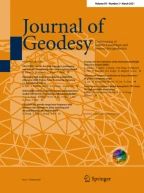Abstract.
The SIGMA-Δ model has been developed for stochastic modelling of global positioning system (GPS) signal diffraction errors in high precision GPS surveys. The basic information used in the SIGMA-Δ model is the measured carrier-to-noise power-density ratio (C/N0). Using the C/N0 data and a template technique, the proper variances are derived for all phase observations. Thus the quality of the measured phase is automatically assessed and if phase observations are suspected to be contaminated by diffraction effects they are weighted down in the least-squares adjustment. The ability of the SIGMA-Δ model to reduce signal diffraction effects is demonstrated on two static GPS surveys as well as on a kinematic high-precision GPS railway survey. In cases of severe signal diffraction the accuracy of the GPS positions is improved by more than 50% compared to standard GPS processing techniques.
Similar content being viewed by others
Author information
Authors and Affiliations
Additional information
Received: 27 July 1998 / Accepted: 1 March 1999
Rights and permissions
About this article
Cite this article
Brunner, F., Hartinger, H. & Troyer, L. GPS signal diffraction modelling: the stochastic SIGMA-δ model. Journal of Geodesy 73, 259–267 (1999). https://doi.org/10.1007/s001900050242
Issue Date:
DOI: https://doi.org/10.1007/s001900050242
